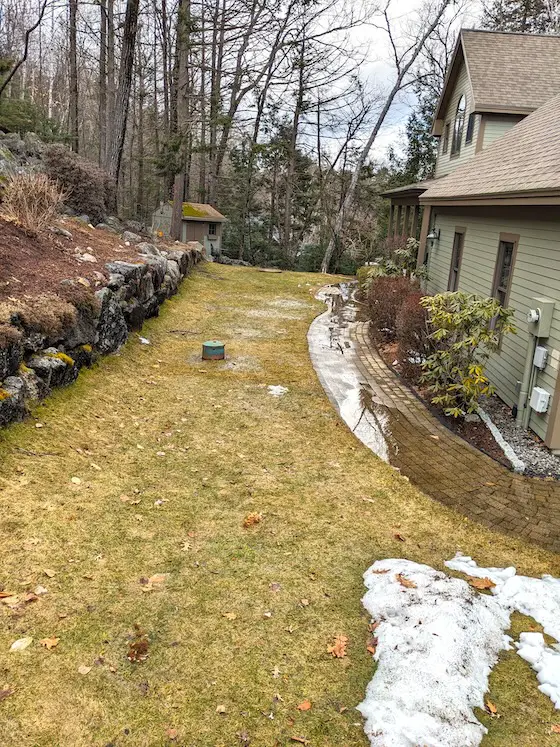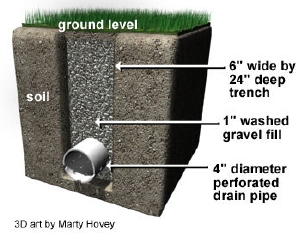Water Ponding Against Foundation

This ponding water in front of the house foundation can cause many problems. There’s an easy way to prevent it. Copyright 2024 Tim Carter
Water Ponding Against Foundation - It Doesn't Always Cause Wood Rot
Two days before writing this column I saved an Ohio homeowner $30,000.00. Fortunately, he stumbled across my website and found out that he could talk to me on the phone. He was suffering from water ponding against his foundation and was considering signing a contract with a waterproofing company for the above amount.
Once I studied the photographs he sent me, I said, “Are you sitting down? That ponding water is NOT causing the problem you’re having. If you would have signed that contract, you would have wasted all that money.”
There was stunned silence at the other end of the phone. I discovered moments later I was hearing the sound of relief! This man had been suffering angst about the huge cost for over a year! A wave of gratefulness was washing over him knowing I had helped bolster his retirement income.
It’s important to realize that ponding water is not a good thing. I’ll deal with that in a moment sharing how to prevent it or deal with it should you have the same problem. For now, let’s talk about the problem he had.
The man shared he had discovered, quite by accident, the bandboard that caps the ends of his floor joists was rotting. I could see from his photographs the bandboard was at least 16 inches above the soil around his foundation. The ponding water was not able to leak into his house and contact these boards.
I asked if he had any signs of water leaking into his basement. His answer was “No.” After asking a few other questions I said, “The wood rot you’re experiencing is caused by condensation that’s forming in the winter months on the cold wood. The moisture can’t easily evaporate because of the 6-inch-thick pieces of fiberglass insulation that are placed in contact with the wood.”
My advice was to remove all the fiberglass allowing the wood to dry. I then shared a few ways to repair any severe rot. Once the wood was dry and all repairs were complete, I instructed him to install 4 10inches of closed-cell foam insulation. This rigid material must be custom cut and fit tight between the floor joists, subfloor, and sill plate. Once in place, a spray can of expanding foam should be used to fill any small cracks between the wood and the foam. The closed-cell foam will prevent water vapor from contacting the band board in the future.
We then discussed why the water was ponding against his house. He admitted he caused part of the problem at the front by installing raised landscape beds. I told him this was not a good idea. Unfortunately, many landscapers don’t understand the minimum requirements set forth in the uniform building code.
The minimum grading standards in the code state that the ground must slope down and away from each foundation wall at least six inches in the first ten horizontal feet of distance away from the foundation wall. What’s more, the code states that a minimum of 6 inches of foundation must extend above the ground that touches the foundation.
Do the math. This means the top of a foundation wall should be a minimum of 12 inches higher than the ground that’s 10 feet away from the foundation. Houses built on hillsides have a difficult time meeting this requirement on the uphill side of the house.
More fall is better. Try for nine or twelve inches of fall instead of six. Remember, the building code is a set of MINIMUM standards of building. When you build your home to code, it’s like getting a 70 percent on a test. You just barely pass. You can always build better than the building code.
My suggestion to him was to install one of the linear french drains I’ve talked about for over thirty years. My college degree was in geology with a focus on hydrogeology. That’s the study of groundwater.

Cross-section of a Linear French Drain including the all-important perforated french drain pipe. Copyright 2017 Tim Carter ALL RIGHTS RESERVED - Do NOT COPY this graphic.
This man’s house is located in a region where the subsoil is a dense clay. Rainwater enters the top soil and then only goes down about four inches before it encounters this clay. The water then starts to move along sideways across the top of the clay.
A linear french drain is like a gutter in the ground. It’s a narrow 6-inch-wide trench that only needs to be 24 inches deep. In some cases, it can be less, and in other cases more. Most of the time 24 inches is plenty.
You install two inches of clean gravel the size of white grapes in the bottom of the trench. Then you install a perforated pipe on top of this gravel. The pipe acts like a high-speed highway transporting the water to the lowest part of the lot. Once the pipe is installed, you fill the trench to the top with the same grape-sized gravel. Never use gravel with sand in it. Do not line the trench with filter fabric. Do not install a filter sock on the pipe.
I have videos and in-depth columns on my www.AsktheBuilder.com website all about linear french drains, downspout drain lines, and getting foundation heights correct. I suggest you immerse yourself in all of them.
Column 1551